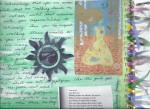 LIGHT ON LIFE by B.K.S. Iyengar changed my life with its straightforward, head-on approach to the questions we face as we live. As we live a life that includes the multi-limbed practice of yoga, we encounter quandaries that challenge our decisions about how to live in a world of other people also challenged by their own questions. Iyengar’s book written in 2005 is presumably his final chapter offering in a long list of quality books he has penned about yoga, meditation, and spirituality. LIGHT ON LIFE resonated with me and continues to provide a source of go-to support when I’m seeking a way to explain or make sense of a rarely perfect existence. What Iyengar offers is plain talk about the freedom that awaits those who make the yoga journey. The trip includes profound and not so intense moments, but Iyengar reminds us that recognition of the smallest things is a profound step in the direction of peace. And then we are asked to share that with our communities.
LIGHT ON LIFE by B.K.S. Iyengar changed my life with its straightforward, head-on approach to the questions we face as we live. As we live a life that includes the multi-limbed practice of yoga, we encounter quandaries that challenge our decisions about how to live in a world of other people also challenged by their own questions. Iyengar’s book written in 2005 is presumably his final chapter offering in a long list of quality books he has penned about yoga, meditation, and spirituality. LIGHT ON LIFE resonated with me and continues to provide a source of go-to support when I’m seeking a way to explain or make sense of a rarely perfect existence. What Iyengar offers is plain talk about the freedom that awaits those who make the yoga journey. The trip includes profound and not so intense moments, but Iyengar reminds us that recognition of the smallest things is a profound step in the direction of peace. And then we are asked to share that with our communities.
“Yoga is the rule book for playing the game of Life, but in this game no one needs to lose. It is tough, and you need to train hard. It requires the willingness to think for yourself, to observe and correct, and to surmount occasional setbacks. It demands honest, sustained application, and above all love in your heart. If you are interested to understand what it means to be a human being, placed between earth and sky, if you are interested in where you come from and where you will be able to go, if you want happiness and long for freedom, then you have already begun to take the first steps toward the journey inward.” (LIGHT ON LIFE, B.K.S. Iyengar)
There are five primary areas of practice to the Writer Wellness plan. Every other week I will post an idea for relaxation (Monday Meditation,) creative play (Tuesday Tickle,) fitness and exercise (Wednesday Workout,) journaling and misc. (Thursday Thought,) and nutrition (Friday Feast.)
Meanwhile, remember to look for a digital or print copy of Writer Wellness, A Writer’s Path to Health and Creativity at Who Dares Wins Publishing, http://whodareswinspublishing.com.
And check out these great blogs for ideas to keep your writing and publishing healthy and prosperous.
http://writeitforward.wordpress.com/ Bob Mayer
http://jenniholbrooktalty.wordpress.com/ Jenni Holbrook
http://warriorwriters.wordpress.com/ Kristen Lamb
http://inspiration4writers.blogspot.com/ Inspiration for Writers, Inc.
http://pentopublish.blogspot.com/ Natalie Markey
http://amyshojai.com Amy Shojai
Check out my new website Joy E. Held
Have you subscribed to this Writer Wellness blog yet? Get email updates when a new post is added. Click “subscribe” and leave your email. That’s it and thanks in advance!
Be well, write well






